|
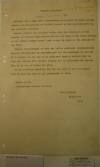
|
1. Jan. 28, 1929.
G-2 Report on Sandino Situation,
Major Fred T. Cruse, Military
Attaché, Tegucigalpa.
"SANDINO SITUATION. ¶ Attached
are a copy and a translation of
a letter in which Sandino
accepts the resignation of
Froylan Turcios as his
Representative on the American
Continent. ¶ Tenorio secured the
original letter from the
messenger on the morning of
January 25th. Turcios has not
yet seen it and knows nothing of
it having reached here. I sent a
copy by plane to the Marines on
the 27th. ¶ Tenorio has arranged
to have the letter published
simultaneously here, in
Salvador, and in Guatemala, and
for the messenger to deliver it
to Turcios on the day it is
published here. We believe that
in this way Turcios will believe
Sandino had it published and
realize that he is out of things
for good. ¶ We are watching
carefully for the men sent to
get the papers from Turcios and
hope to get possession of them.
¶ Report No.87. ¶
Tegucigalpa--January 28, 1929. ¶
Fred T. Cruse, ¶ Major, G.S. ¶
M.A."
|
|
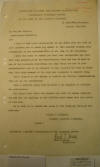
|
2. Jan. 7, 1929.
G-2 Report on Sandino Situation:
Translation of Letter from
Sandino Accepting the
Resignation of Froylán Turcios
as his Agent of the American
Continent, Major Fred T. Cruse,
Military Attaché, Tegucigalpa.
"TRANSLATION
OF LETTER FROM SANDINO ACCEPTING
THE RESIGNATION OF FROYLAN
TURCIOS AS HIS AGENT ON THE
AMERICAN CONTINENT. ¶ El
Chipotón, Nicaragua, ¶ January
7th, 1929. ¶ Mr. Froylan
Turcios, ¶
Tegucigalpa--Honduras. ¶ Sir: ¶
I have at hand your letter,
dated in the above city the 28th
of last December, and in which
you submit to this Supreme
Command your resignation as the
Representative of our Army on
the Continent. ¶ I have the
honor to inform you that your
resignation has this date been
accepted, with the understanding
that you are to make no use of
the documents concerning our
Army which are now in your
possession, but are to be
prepared to duly account for
them to whomever this High
Command of the Army may
designate to receive them. ¶
Until then, we do not desire to
receive any further
communications from you in our
cantonments. ¶ When I consider
cases such as yours I am
reminded of DIOGENES the
philosopher. ¶ You forgot that
while the bazaars are full of
wooden soldiers the men who are
fighting in the SEGOVIAS have
ideas that are worthy of such
men. ¶ Be so kind as to inform
the press of the world, by
radio, of our attitude. ¶ PATRIA
Y LIBERTAD. ¶ (Signed) Augusto
C. Sandino. ¶ (Seal.) ¶
Certified a correct translation
of the original letter. ¶ Fred
T. Cruse, ¶ Major, G.S."
|
|
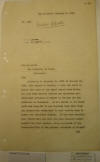
|
3. February 4, 1929.
Cable on Sandino Situation, US
Consul R. M. de Lambert, San
Salvador, to Sec. State, p. 1.
"San Salvador, February 4, 1929.
¶ No. 1496 ¶ The Honorable ¶ The
Secretary of State, ¶
Washington. ¶ Sir: ¶ Referring
to despatch No. 1487 of January
26, 1929, with regard to
Sandino, I have the honor to
report that most of the local
papers have during the past week
carried various and sometimes
contradictory articles in regard
to the men and the situation in
Nicaragua. As was stated in the
above mentioned despatch it was
reported here that Froylán
Turcios had endeavored to have
Sandino come to terms with
President Moncada. It has more
recently been stated that not
only was this endeavor
unsuccessful but that Sandino,
being convinced of the
incompatability of the present
interests of himself ¶ and . . .
"
|
|
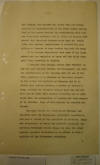
|
4.
February 4, 1929. Cable on
Sandino Situation, US Consul R.
M. de Lambert, San Salvador, to
Sec. State, p. 2.
" . . . and Turcios, has removed
the latter from his former
position as representative of
the rebel leader abroad. Most of
the papers carried the
announcement that “all are
abandoning Sandino”, and LA
PRENSA of January 29th stated
that President Moncada would
send Dr. Julián Irías with
special instructions to solicit
the good offices of Turcios to
have Sandino lay down his arms.
¶ It is perhaps significant that
most of the local papers now are
beginning to leave off the title
“General” when referring to
Sandino. ¶ A despatch from
Managua states that “Sandino is
now the most serious problem for
Nicaragua”, and that the
pacification of the Segovias
will be one of the first
problems to be attacked by
President Moncada. In the DIARIO
DEL SALVADOR of February 3rd it
is stated that Captain Paredes,
a member of Sandino’s army,
visited San Salvador several
days ago and had with him an
order from Sandino directing him
to make known that the
resignation of Turcios had been
accepted by Sandino. Copy of
this article is herewith
enclosed. ¶ The same DIARIO DEL
SALVADOR of February 3rd
reported that the Nicaraguan
Autonomist Association has sent
a letter to the President of
Salvador, (copy and translation
of which are herewith enclosed)
requesting President Romero
Bosque to join the other Central
American Presidents in an effort
to find a solution of the
Nicaraguan situation. ¶ I . . .
"
|
|
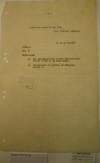
|
5.
February 4, 1929. Cable on
Sandino Situation, US Consul R.
M. de Lambert, San Salvador, to
Sec. State, p. 3.
"
. . . I have the honor to be,
Sir, ¶ Your obedient servant, ¶
R. M. de Lambert ¶ RMdeL:S ¶ 800
N ¶ Enclosures: ¶ 1. Two
clippings from DIARIO DEL
SALVADOR marked 1 and 2. (1 copy
each). ¶ 2. Translation of
portion of clipping marked 2."
|
|
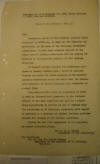
|
6.
February 4, 1929.
Cable on Sandino Situation,
Enclosure No. 2, Diario del
Salvador, Feb. 3, 1929
(English Translation), US Consul
R. M. de Lambert, San Salvador,
to Sec. State, p. 4.
"Enclosure
No. 2 to despatch No. 1496,
dated February 4, 1929, from San
Salvador. ¶ (DIARIO DEL SALVADOR
– Feb. 3) ¶ Sir: ¶ Knowing as
you do of the internal conflict
which Nicaragua is suffering, we
pray you for humanity and
patriotism, in the name of the
Nicaraguan Autonomist
Association, to lend your
valuable support to the other
Central American Presidents for
the purpose of arriving at an
honorable solution of that
serious situation. ¶ If General
Moncada accepts the conference
proposed by General Sandino upon
a basis of national dignity and
under the moral auspices of the
Central American Governments we
do not doubt that the lamentable
situation of sister Nicaragua
will terminate in a short time.
¶ Your participation will be
beneficial in order to make an
international precedent in the
internal affairs of the weak
countries and will be a
propitious opportunity to
perform an act of justice upon
the initiative of El Salvador,
especially with regard to
arriving at a solution of
Central American problems
through the joining of the
brother countries. ¶ Hoping for
the kind acceptance of our
proposal, we remain sincerely
yours. ¶ /s/ J. de J. Zamora ¶
President of the Association ¶
His Excellency ¶ Sr. Dr. don Pio
Romero Bosque, ¶ President of
the Republic of El Salvador, ¶
E.S.D.O."
|
|
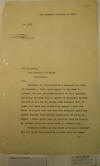
|
7.
February 8, 1929.
Cable on Sandino Situation, US
Consul R. M. de Lambert, San
Salvador, to Sec. State, p.
1.
"San Salvador, February
8, 1929. ¶ No. 1502 ¶ The
Honorable ¶ The Secretary of
State, ¶ Washington. ¶ Sir: ¶
Referring to this Legation’s
despatch No. 1376 of November 2,
1928, with regard to one José L.
Paredes, who had presented
himself at this Legation as
having formerly been a member of
Sandino’s forces, who was on his
way to Mexico, and believed that
he might find some way of
securing peace, I have the honor
to report that the same man
recently again has passed
through this capital apparently
en route to Mexico – which would
seem to indicate that he
rejoined Sandino after his visit
here in October last. ¶ “Captain
Paredes of the Staff of General
Sandino” did not visit this
Legation on this trip but seems
¶ to . . . "
|
|
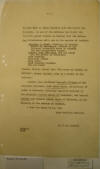
|
8.
February 8, 1929.
Cable on Sandino Situation, US
Consul R. M. de Lambert, San
Salvador, to Sec. State, p.
2. "
. . . to have been in close
relation with the DIARIO DEL
SALVADOR. In one of its articles
the DIARIO DEL SALVADOR quoted
Paredes as stating that the
following Salvadoreans still are
in the service of Sandino: ¶
Augustin F. Marti, Secretary of
Sandino, native of Teotepeque,
student of the National
University where he founded the
anti-imperialist league. ¶
General José León Díaz, who has
under him the column in
Chontales. ¶ Adam González ¶
Guillermo Ajuria ¶ Luis Marin ¶
José Augustin González ¶ and one
other. ¶ Paredes further stated
that “the woman of Sandino in
bivouac”, Teresa Espinol, also
is a native of San Salvador. ¶
Paredes also mentioned Gregorio
Gilbert of the Dominican
Republic; José Jiron Ruano,
Ex-governor of Petén of
Guatemala (recently reported
captured by the marines); Carlos
Aponte of Venezuela, and General
Montoya and Colonel Manuel Lagos
of Honduras, as now figuring in
the service of Sandino. ¶ I have
the honor to be, Sir, ¶ Your
obedient servant, ¶ R. M. de
Lambert ¶ RMdeL:S ¶ 800N"
|
|
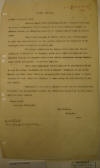
|
9.
February 12, 1929.
G-2 Report on Sandino Situation,
Major Fred T. Cruse, Military
Attaché, Tegucigalpa.
"SANDINO SITUATION. ¶ CAPTURE OF
GENERAL JIRON. ¶ General Manuel
Maria Jiron Ruano, Sandino’s
Chief of Staff since the middle
of August, and former commander
of the field force, was captured
on February 3d near San Albino.
When taken he was alone, riding
on a mule toward the south. ¶
When I left Nicaragua no further
details were available, but I am
quite sure than Jiron, who was
with Sandino solely for the
excitement of the affair, got
tired of inaction and pulled
out. ¶ The Marines offered him
his freedom if he would lead
them to Sandino, and on Feb. 4th
he was leading a patrol in an
effort to carry out this plan.
This fact, and the complete
wreck of the outside connections
through Turcios, leave Sandino
nothing but a discredited
fugitive. ¶ When I left
Tegucigalpa Tenorio urged me to
tell General Feland to keep the
Marines absolutely out of it. If
Moncada’s volunteers or men of
the Guardia are killed there
will be no propaganda, but every
time a Marine is killed it gives
the whole affair new life. This
is sound policy and will
probably be put into effect. ¶
Finally, President Moncada
informed me that the new
administration in Honduras was
co-operating willingly and
effectively and that he was not
worried about the final outcome.
¶ Report No.90. ¶ San Jose--Feb.
12, 1929 ¶ Fred T. Cruse, ¶
Major, G.S. ¶ M.A."
|
|
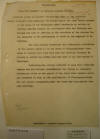
|
10.
January 29, 1929.
“Argentine Paper ‘La Nación’
Against the Rebel of the
Segovias,” translation of
article from El Comercio of
Managua.
"TRANSLATION. ¶ From “EL
COMERCIO” of Managua--January
29, 1929. ¶ ARGENTINE PAPER “LA
NACION” AGAINST THE REBEL OF THE
SEGOVIAS. ¶ Buenos Aires,
27.--The newspaper “La Nacion”,
which for many months defended
the cause of the Nicaraguan
rebel Sandino, in an article of
Saturday evening changes its
pro-Sandino tone and fiercely
criticizes his idea of dividing
up the territory of the country
for the integrity of the
sovereignty of which he was
supposed to be fighting. ¶ The
same article criticizes the
destructive activities of the
Sandino hosts in in the North of
Nicaragua, where thousands of
dollars have been kept from the
national Treasury by failure to
gather the coffee crop, the base
of all the wealth of Nicaragua.
¶ Concluding, the article
referred to says that President
Moncada has the fullest
justification for trying to
eliminate Sandino, and calls on
the people of the other four
Central American republics to
help in the pacification of
Nicaragua, rooting out all
Sandino propaganda, since the
cause has degenerated into pure
banditry. ¶ Certified a correct
translation"
|
|
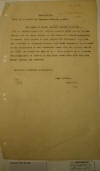
|
11.
February 1, 1929.
“The Press of Mexico Against
Augusto C. Sandino,” translation
of article from
El Comercio
of Managua, p. 1.
"TRANSLATION. ¶ FROM “EL
COMERCIO” of Managua--February
1, 1929. ¶ THE PRESS OF MEXICO
AGAINST AUGUSTO C. SANDINO. ¶
City of Mexico--31st.--The
letters recently given out by
Froylan Turcios put the rebel
Sandino in the class of a
lunatic, according to several
local papers in this capital.
“El Universal” says that the
President of Nicaragua, General
José María Moncada, is quite
right in his declaration to the
Associated Press that the
pretensions of the rebel are
absurd and that he is a false
patriot and a lunatic. The
resignation of Turcios is the
first heavy blow that that the
bandit Sandino has suffered. ¶
Certified a correct translation.
¶ Fred T. Cruse, ¶ Major, G.S. ¶
M.A."
|
|
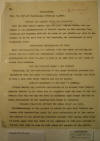
|
12.
February 1, 1929.
“Turcios and Sandino break off
Relations,” translation of
article from
El Sol of
Tegucigalpa, p. 1.
"TRANSLATION. ¶ From “EL SOL”,
of Tegucigalpa--February 1,
1929. ¶ TURCIOS AND SANDINO
BREAK OFF RELATIONS. ¶ When the
news became public that the poet
Froylan Turcios had resigned as
the representative of General
Sandino on the American
Continent, we got together with
him in order to get details and
give to the readers of EL SOL
some idea of the beginning and
development of this unextected
[unexpected] event. ¶
SENSATIONAL DECLARATIONS TO
COME. ¶ Señor Turcios, receiving
our emissary with his usual
cordiality, informed him that
there are sensational details
concerning the Sandino affair,
which he would be glad to give
us at such time as the march of
events made suitable. ¶ HAS THE
CAMPAIGN TAKEN A NEW COURSE? ¶
Underlying all the conversation
of the great Honduran poet, was
the indication that the cause so
heroically defended by Sandino
was about to take a turn with
which Turcios was not in accord.
¶ TURCIOS RESENTFUL OF THE
HERO’S LETTERS. ¶ Without making
any positive declaration, it is
evident that Turcios rejects
Sandino’s new ideas and is
disgusted with the tone of his
letters, so that the two men who
have in different ways fought
the war of Latin Americanism in
the Segovias have begun to
disagree. ¶ STRAINED RELATIONS
BETWEEN THE REBEL CHIEF AND
POET. ¶ Nevertheless, up to the
present it cannot be said that
Turcios has broken with Sandino.
When asked for some declaration
as to the matter the subject of
our interview contented himself
with saying that until he hears
again from the Chief of the
Segovias he will have nothing to
say, but that when he does he
will cover all aspects of the
affair. . . . "
|
|
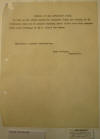
|
13.
February 1, 1929.
“Turcios and Sandino break off
Relations,” translation of
article from
El Sol of
Tegucigalpa, p. 2.
".
. . ENEMIES OF THE AUTONOMIST
CAUSE. As long as the
affair cannot be presented fully
and clearly, it is considered
best not to publish anything
about it, for fear that enemies
might take advantage of it to
damage the Cause."
|
|
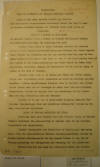
|
14.
February 3, 1929.
“Cause of the Break between
Sandino and Turcios,”
translation of article from
El Comercio of Managua, p.
1.
"TRANSLATION.
¶ From “EL COMERCIO”--of
Managua--February 3d, 1929. ¶
CAUSE OF THE BREAK BETWEEN
SANDINO AND TURCIOS. ¶ His
Continental Representative
Considered Absurd The Plan To
Land At Corinto, Overthrow
Moncada and Proclaim Pedro José
Zepeda As President. ¶ TURCIOS’S
LETTER ON THIS PLAN. ¶ In
December Sandino wrote a letter
to Froylán Turcios, his General
Representative, outlining the
following new plan. ¶ Sandino
would agree to cease fighting
provided the Marines evacuated
four Departments: Estelí,
Matagalpa, Jinotega and Nueva
Segovia while Sandino was
disarming his men and turning
over his arms to Moncada;
Sandino, however, would only
turn in part of the arms,
keeping most of them hidden in
the bush; likewise, his men
would remain in these four
Departments ostensibly engaged
in agriculture but in reality
ready to gather at the call of
Sandino. ¶ Sandino would then go
to Mexico, and while the United
States troops were completing
their evacuation he would be
secretly getting together a
strong expeditionary force, to
move by sea: when all United
States troops were out of
Nicaragua he would land his
expeditionary force, taking
Corinto by sea, and with the
assistance of his former army,
invading Chinandega, Leon and
Managua. ¶ Moncada to be put out
of power, Pedro J. Zepeda
declared Provisional President,
and then new elections called,
with Sandino as the only
presidential candidate. ¶ REPLY
OF TURCIOS REJECTING THE PLAN. ¶
Following this plan Sandino has
sent various agents to Mexico.
Turcios denounced the plan,
writing to Sandino that it was
foolish, impractical and
unpatriotic. ¶ Sandino
disregarded the objections of
Turcios, and was going ahead
with the plan, whereupon Turcios
resigned, informing Sandino by
letter. Sandino, furious, wrote
him the famous letter of the 7th
of January, accepting the
resignation and breaking off all
relations. ¶ Turcios has not yet
seen the letter, but knows its
contens [contents] . . . " [last
line(s) cut off]
|
|
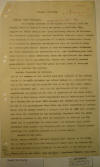
|
15.
February 3, 1929.
“Cause of the Break between
Sandino and Turcios,”
translation of article from
El Comercio of Managua, p.
2.
"SANDINO SITUATION. ¶
General Staff Disbanded.
¶ As a result probably of the
capture of General Jirón the
General Staff of Sandino’s force
has broken up. José Léon Díaz,
Salgado and Simeon Montoya have
been definitely located in
Honduras. The Government
immediately informed Dr. Julian
Irías, on special mission from
Nicaragua to the inauguration of
Dr. Mejía Colindres. The former,
in a telegram to President
Moncada, stated that all
Sandino’s jefes had deserted,
but Tenorio informs me that
Colindres, Aponte Hernandez, and
Pedro Altamirano are undoubtedly
still with him. However, the
field force ceased to exist
immediately after the election,
and the General Staff is now out
of existence. This leaves only
Sandino’s personal group.
Tenorio insists that this group
is still close to Murra, and I
have so informed the Marines. ¶
Sandino Situation in
Salvador. ¶ One of the
members of the Mission sent from
Salvador to the inauguration of
Dr. Mejía Colindres was Arturo
Lara. He is a newspaper man, and
I have known him for years. He
told me he was the press censor,
so in a two-hour talk I gave him
all the details of the Sandino
campaign. He was amazed at the
lack of magnitude of the whole
thing. He told me that he, and
other responsible men in
Salvador, had believed that
Sandino had at least 2000 men,
that the Marines has lost
hundreds of men in the campaign,
and that there was every
likelihood of Sandino being able
to defeat Moncada. I arranged
for him to talk with Tenorio,
and after the interview he was
completely disgusted with the
whole affair. He promised to see
that the newspaper in Salvador
got the truth and he apparently
did so, because I am informed
that almost overnight they
dropped the business, even the
violent “Diario Latino”
admitting the complete collapse
of the whole affair. ¶
Sandino’s Wife Held. ¶
Blanca Arauz, Sandinó’s wife,
was brought into Managua on the
12th, and is being held there.
The newspapers stated this was
because she had been keeping
Sandino informed of movements of
the Marines and Guardia. It is
not likely that she had. I
questioned Tenorio very care- .
. . "
|
|
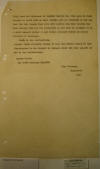
|
16.
February 3, 1929.
“Cause of the Break between
Sandino and Turcios,”
translation of article from El
Comercio of Managua, p. 3.
" . . . fully upon his return,
as to whether Sandino had ever
gone to visit her, and so on. He
told me that Sandino paid no
attention to her and that the
only reason they were ever
married was that Sandino had
been running with her for years,
that at the time he expected to
be a great man, and wanted to
get things straight before he
became Dictator of Nicaragua. ¶
Jirón in the
Penitentiary. ¶ General
Jirón evidently failed to lead
the Marine patrol to Sandino,
because he was brought to
Managua about ten days ago, and
is now in the Penitentiary. ¶
Report No.95. ¶ San
José--February 22, 1929. ¶ Fred
T. Cruse, ¶ Major, G.S. ¶ M.A."
[NOTE:
Latter claim on Gen. Girón
false; Girón
executed in the bush by Hanneken
& Escamilla on March 2,
1929:
Top 100, p. 27
]
|
|
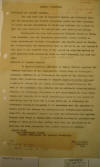
|
17. March 7, 1929.
G-2 Report on Sandino Situation,
Major Fred T. Cruse, Military
Attaché, Tegucigalpa.
"SANDINO SITUATION. ¶
Propaganda now Against Sandino.
¶ Not only have most of
Sandino’s leaders and followers
quit, but the widespread and
vicious propaganda system has
been definitely turned against
him. Machado in Mexico may
continue for a while to give him
some notice in “El Machete”, but
even that is not likely. ¶
Turcios, who has just been
appointed Honduran Consul in
Paris, will certainly give out
interviews unfavorable toward
Sandino on every occasion, and
Dr. Pedro J. Zepeda, who was
Sandino agent in Mexico, has
resigned, with the announcement
that as far as he can see
Sandino’s only plan is the
complete ruin of the region he
occupies, instead of some
agreement with Moncada by which
he could honorably lay down his
arms. ¶ Mafuenic to
Succeed Turcios. ¶ In a
letter recently published in
Mexico Sandino appoints the
Central Committee of the
organization “Manos Fuera de
Nicaragua”, generally referred
to as Mafuenic, as his agent on
the American Continent. This
Committee consists of Machado,
Zepeda, Dr. Carlos Leon, and a
couple of others. All are pretty
thoroughly disillusioned, so the
work of the committee will
probably not be active. In
Salvador, Mexico, Honduras and
Nicaragua propaganda is now
anti-Sandino. In Costa Rica,
Panama and Colombia it is still
favorable, at least to the
extent of publishing that he
still has a large force and is
defeating the Government forces.
In Guatemala it is uncertain
what the reaction to recent
events has been, as the
revolution has overshadowed
anything else. With the material
I have I can turn the newspapers
here against him, and also those
in Panama. Their attitude is
largely ignorance and having no
other source they publish what
they can get, which up to date
has all been propaganda from
either Turcios or Machado. ¶
Report No.99 ¶ San José--March
7, 1929. ¶ Source--Newspapers
and personal knowledge. ¶ Fred
T. Cruse, ¶ Major, G.S. ¶ M.A."
|
|
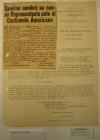
|
18.
January 18, 1929.
“Sandino nombró su nuevo
Representante ante el Continente
Americano / Sandino Names his
New Representative for the
American Continent,” translation
of article from
El Comercio
of Managua.
"Sandino nombró su nuevo
Representante ante el Continente
Ámericano ¶ Habrá
representaciones en todos los
países del mundo ¶ La Prensa de
San Salvador publica lo
siguiente: ¶ Cuartel General del
Ejército Defensor de la
Soberanía Nacional de Nicaragua.
¶ El suscrito, General y Jefe
Supremo del Ejército Defensor de
la Soberanía Nacional de
Nicaragua, en uso de las
facultades conferidas por el
mismo Ejército, teniendo en
consideración que el señor
Froylán Turcios presentó ante
este Com[hole in paper]nte
General su renuncia de
Representante General de nuestro
Ejército en el Continente, la
cual le fue aceptada con fecha 7
del actual, ¶ Acuerda: ¶ Confiar
dicha Representación General en
el Continente al Comité Manos
Fuera de Nicaragua, con sede en
México, D. F, facultando al
mismo Comité para designar las
representaciones que él juzgue
necesarias en el mundo en
general, pero siempre en
carácter colectivo como la que a
él se le confiere, para evitar
el monopolio de las noticias
procedentes de nuestro Cuartel
General, que tanto urge a
nuestra Causa que sean conocidas
por el mundo civilizado. ¶ El
Chipotón, Nicaragda,
[Nicaragua,] C.A., enero
dieciocho de mil nocientos
veintinueve y año décimo séptimo
de Lucha Anti Imperialista en
Nicaragua. ¶ Patria y Libertad.
¶ A. C. SANDINO. ¶ (Firmada y
sellada.) ¶ FROM “EL COMERCIO”
MANAGUA. ¶ SANDINO NAMES HIS NEW
REPRESENTATIVE FOR THE AMERICAN
CONTINENT. ¶ WILL BE REPRESENTED
IN ALL THE COUNTRIES OF THE
WORLD. ¶ LA PRENSA, of San
Salvador, publishes the
following: ¶ Headquarters of The
Army of Defense of the National
Sovereignty of Nicaragua. ¶ The
undersigned, General and Supreme
Commander of the Army of Defense
of the National Sovereignty of
Nicaragua, by authority
conferred by the said Army, and
in view of the fact that Señor
Froylan Turcios has resigned as
the General Representative of
our Army on the Continent, which
resignation was accepted under
date of January 7th: ¶ It is
agreed: ¶ To entrust the said
Representation in General on the
Continent to the Committee Manos
Fuera de Nicaragua, located in
Mexico, Distrito Federal,
authorizing the said Committee
to appoint such representatives
to the world at large as they
may deem necessary; provided
that such representation shall
be collective, as in the present
case, so that there may be no
monopoly on the news from our
Headquarters, which for the sake
of our Cause must be known to
all the civilized world. ¶ El
Chipotón, Nicaragua, C.A. ¶
January 18, 1929, and 17th year
of the Anti-Imperialistic War in
Nicaragua. ¶ Patria y Libertad.
¶ A.C. Sandino. ¶ (Signed and
sealed.)" [NOTE: see
EDSN-Docs 29.01.18a]
|
|
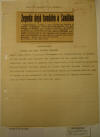
|
19. ca. March 19,
1929. “Zepeda dejó también
a Sandino / Zepeda has also
dropped Sandino,” translation of
article from
El Comercio
of Managua.
"From
“El Comercio” of Managua. ¶
Zepeda dejó también a Sandino ¶
Ciudad Mexico – Pedro J. Zepeda,
nicaragüense representante de
Sandino en esta capital, ha
renunciado su cargo en vista de
que la resistencia y
pretensiones de Sandino, han
degenerado en bandolerismo.
Parece que Froylán Turcios en
una carta, hizo ver a Zepeda que
Sandino lo único que pretende es
la desolación completa del
territorio que ocupa, negándose
a un entendimiento favorable con
el gobierno del General Moncada
para deponer honrosamente las
armas. ¶ TRANSLATION. ¶ ZEPEDA
HAS ALSO DROPPED SANDINO. ¶
Mexico City--Pedro J. Zepeda, a
Nicaraguan and representative of
Sandino in this capital, has
resigned his position for the
reason that the resistance and
plans of Sandino have
degenerated into banditry.
Apparently Froylan Turcios
informed Zepeda by letter that
all Sandino intends is the
complete desolation of the
territory which he occupies,
with no idea of coming to any
agreement with the Government of
General Moncada, so that he
could honorably lay down his
arms." [NOTE: a false report -
Zepeda did not resign ]
|
|
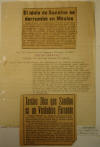
|
20.
February 13, 1929.
“El ídolo de Sandino se derrumbó
en Mexico / Sandino the Idol has
toppled in Mexico,” translation
of article from
El Comercio
of Managua.
"El ídolo de Sandino se
derrumbó en México ¶
Ciudad Mèxico 11. – Desde la
renuncia de Froylán Turcios,
como representante del rebelde
nicaragüense Sandino, todo
cuando dice el último se loma
como una quijotada en esta
capital. Turcios íntimamente ha
declarado en sus últimas cartas,
que lo que se creía patriotismo
en Sandino, ha degenerado en
farsa, ya que el rebelde rehusa
los esfuerzos que el gobierno de
Moncada hace para levantar la
triste situación en que desde
hace largos dos años se ha
sometido la región invadida por
él. El triunfo del liberalismo
hondureño ha venido si se
quiere, virtualmente a terminar
con las pretenciones funestas de
Sandino ya que ahora no tendrá
frónteras donde refugiarse para
escapar a los derechos de orden
de que se ha investido a Moncada
por la voluntad del pueblo
concien le de Nicaragua. ¶ From
“El Comercio”--of
Managua--February 13, 1929. ¶
SANDINO THE IDOL HAS TOPPLED IN
MEXICO. ¶ Mexico
City--11th.--Since the
resignation of Fryolan Turcios
as representative of the
Nicaraguan rebel Sandino
everything the latter says is
taken as an absurdity in this
capital. Turcios, in private
letters has stated
confidentially that what was
supposed to be patriotism in
Sandino has degenerated into
farce, since the rebel has
rejected all efforts of the
Government of Moncada to lighten
the sad conditions to which for
two long years the region
invaded by him has been
subjected. The triumph of
liberalism in Honduras has
really put an end to the
pretensions of Sandino since he
no longer will have a frontier
refuge wherein to escape from
the arm of the law, placed in
the hands of Moncada by the
thinking people of Nicaragua. ¶
Turcios Dice que Sandino
es un Verdadero Farsante
¶ CIUDAD MEXICO, 11. – Desde la
renuncia de Froylán Turcios como
representante del rebelde
nicaragüense Sandino, todo
cuanto dice el último se toma
como una quijotada en esta
capital. ¶ Turcios últimamente
ha declarado en sus cartas, que
lo que se creía patriotismo en
Sandino ha degenerado en farsa,
ya que el rebelde rehusa los
apoyos que el Gobierno de
Moncada hace para levantar la
triste situación a que desde
hace largos dos años se ha
sometido la region invadida por
él. El Liberalismo hondureño ha
venido, si se quiere,
virtualmente a terminar con las
pretensiones funestas de
Sandino, ya que ahora no tendrá
fronteras donde refugiarse para
escapar a los derechos do orden
de que se ha investido a
Moncada, por la voluntad
consciente del pueblo [paper
folded] Nicaragua."
|
|
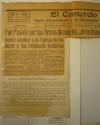
|
21. March 9, 1929.
“Fué Pasado por las Armas Manuel
Ma. Jirón Ruano — Intentó
Conducir a las Fuerzas del
Gobierno a una Emboscada
Sandinista / Manuel Maria Jirón
Ruano Shot — Intended to lead
Government Forces into Sandino
Ambush,” translation of article
from
El Comercio of
Managua.
"Fué Pasado por las
Armas Manuel Ma. Jirón Ruano ¶
Intentó Conducir a las Fuerzas
del Gobierno a una Emboscada
Sandinista ¶ Manuel
María Jirón Ruano, recientemente
capturado por el teniente
Henneken, el mismo que incendió
y destruyó las minas <La Luz> y
<Los Angeles>, en la región de
Pis-Pis y quien ha causado
grandes males al país, fue
juzgado en consejo de guerra,
resultando condenado y pasado
inmediatamente por las armas. ¶
El motivo de su muerte
¶ El motivo de tal fusilación
fue que Jirón Ruano, que se
utilizaba como guía en las
operaciones de persecución del
bandolerismo en la región del
Norte, intentó conducir a las
fuerzas voluntarías a una
emboscada preparada por íos
bandoleros, no obstante que se
le guardaba toda clase de
consideraciones. Sumados sus
delitos anteriores al que
intentaba cometer para que
mataran impunemente a numerosos
soldados, el jefe expedicionario
dispuso fusilarlo, con los
requisitos de ley. ¶
Donde fué fusilado ¶
Jirón Ruano fué fusilado en las
montañas de Murra, hace tres o
cuatro dias. Ignórase el nombre
del Jefe de las fuerzas que
guiaba Jirón Ruano pero se
supone que sea el General
Caldera o el general Escamilla.
¶ Quien era Jirón Ruano
¶ Este jefe sandinista era
guatemalteco, como de 55 años de
edad Desempeño importantes
cargos públicos en el régimen de
Estrada Cabrera; en Honduras fué
Director de Policia de
Chiquimula en la administración
de Estrada Cabrera. ¶ Deja dos
niños y una esposa que
actualmente reside en ciudad de
Guatemala. ¶ MANUEL MARIA JIRON
RUANO SHOT. ¶ INTENDED TO LEAD
GOVERNMENT FORCES INTO SANDINO
AMBUSH. ¶ Manuel María Jirón
Ruano, recently captured by Lt.
Henneken, and the man who burned
and destroyed the “La Luz” and
“Los Angeles” mines, in the
Pis-Pis region, and who has done
great harm to the country, has
been tried by a Council of War,
condemned, and shot. ¶ It
appears that Jirón Ruano, who
was being used as a guide in the
pursuit of bandits in the North,
and who had been treated with
every consideration, planned to
lead the volunteer forces into
an ambush arranged by bandits.
This, taken with his previous
crimes, was too much for the
column commander, who executed
him by due process of law. ¶
Jirón Ruano was executed in the
mountains near MURRA, three or
four days ago. Who was in
command of the column that Jirón
was guiding is not known, but it
is supposed to have been either
General Calders or General
Escamilla. ¶ Jirón was a
Guatemalan, about 55 years old.
During the time of Estrada
Cabrera he held important
Government positions. He has two
children and a wife, who are at
present residing in Guatemala."
|
|
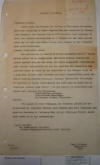
|
22. March 20,
1929. G-2 Report on
Sandino Situation, Major Fred T.
Cruse, Military Attaché,
Tegucigalpa.
"SANDINO SITUATION. ¶ Volunteer
forces. ¶ Since early in
February two forces of
Nicaraguan volunteers have been
operating in Nueva Segovia. They
are commanded by General Juan
Escamilla and General Felipe T.
Flores, Each force consists of
about two hundred men. Escamilla
is a Mexican and was with
Sandino until May of last year.
These forces have cleaned up the
disturbed area quite thoroughly.
¶ Sandino Practically Alone. ¶
The publication of Sandino’s
letter accepting Turcios’
resignation proved to be
unexpectedly effective. Turcios
immediately turned against him
and has swung the whole
propaganda organization into
violent denunciation of him for
wrecking the Cause. This was
followed early in March by the
desertion of the General Staff
in a body. They crossed into
Honduras and were disarmed. This
group included Montoya, Salgado,
Ortez, and Porfirio Sánchez. The
Government of Honduras is openly
anti-Sandino and will give up
these men if President Moncada
asks it, but I do not believe he
will. There now remain with
Sandino the following:- ¶ Col.
Francisco Estrada. ¶ Col.
Coronado Maradiaga. ¶ Dr.
Domingo Mairena Hernandez. ¶
Rumors. ¶ The papers in both
Nicaragua and Honduras publish
an announcement by President
Moncada that Sandino has left
Nicaragua and gone via Honduras
to Salvador. This is not likely,
as Tenorio would have known of
it and informed me. ¶ Report
No.107. ¶ San José--March 20,
1929. ¶ Source--Newspapers:
checked with Tenorio. ¶ Fred T.
Cruse, ¶ Major, G.S. ¶ M.A."
|
|
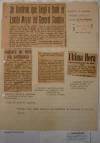
|
23. ca. April 1,
1929. “Typical News Items
showing how Complete is Collapse
of Sandino Cause,” translations
of newspaper articles.
"Se
confirma que Llego a DanlÍ El
Estado Mayor del General Sandino
— Danlí es una de las
poblaciones importantes del
departamento de Paraiso,
Honduras, conlindante este con
el de Nueva Segovia. Queda dicha
ciudad casi en dirección opuesta
a Ocotal y como a treinta leguas
e distancia una de otra. Ha sido
el foco del sandinismo durante
todo el tiempo de la cruzada del
rebelde segoviano. Ayer se nos
afirmó oficialmente la noticia,
ya publicada por este diario, de
la llegada del Estado Mayor de
Sandino a Danlí, después de
haber cruzado la frontera por
Pedregalitos la semana proxima
pasada. Probablemente seguirá
para el interior de Honduras."
•
"CAPTURA
DE OTRO JEFE SANDINISTA — En el
lugar llamado Cifuentes, cerca
de la frontera de Honduras se
capturó al jefe sandinista
Porfirio Sánchez. Vendrá
reconcentrado a Managua. A
proposito de sandinistas, muchos
de estos que ahora se encuentran
en Honduras, además de los que
permanecen en Encinos, han
escrito a personas de Ocotal
diciéndoles que interpongan con
el Comando Americano sus buenos
oficios para que se les permita
el regrreso a sus hogares."
•
"Dos cabecillas Sandinistas
deponen sus armas en Honduras.
Managua, 6. — Han llegado
noticias de Ocotal, dirigidas al
Presidente Moncada por el Juez
de Distrito, informando que el
Jefe sandinista Porfirio Sánchez
con otro cabecilla, Simón
González, y setenta secuaces,
lograron evadir los ataques de
una patrulla que los perseguía y
escaparon hacia Honduras por la
población fronteriza de Jalapa,
rindiéndose a la guarnación
hondureña a la cual entregaron
sus armas."
|
|
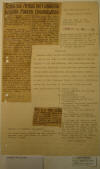
|
24. April 7, 1929.
“Todas las Armas del Cabecilla
Salgado Fueron Decomisadas / All
the Arms of the Commander
Salgado were Confiscated /
Capture of Sandino Messenger,”
translations of newspaper
articles.
"Según el siguiente telegrama
trascrito por el Goberno
hondureño al de Nicaragua, se le
decomisó al cabecilla sandinista
Carlos Salgado, un verdadero
arsenal de guerra, así:
Tegucigalpa, 1.40 pm., 5 abril
1929.—Excmo. Sr. Presidente,
Managua.—Complázcome enviarle
trascripción que me ha sido
enviada por el Excmo. Señor
Ministro de Relaciones
Exteriores. Telegrama:
'Alauca, 3 de abril de 1929.
Señor Presidente. Tengo a honra
comunicarle a Ud. que estos
momentos ingresa a esta la
columna del General Carlos
Salgado, quien disolvió su
gente, las armas y elementos
bélicos lo escondió, pero espías
que le seguían descrubrieron el
lugar donde se [--]laban y hoy a
las nueve de la mañana envié a
Las Partidas, jurisdicción de
este pueblo, se encontraron en
un rancho de paja en el fondo de
una troja de maicillo, 16 rifles
concones, cuatro rifles
Lanzabombas, 12 Sprinfields, 9
calibre 7, MM. y una
ametralladora Lewis en buen
estado. Siete discos para la
misma con 40 cartuchos de
repuesto para la dicha
ametralladora, 27 bombas de
dinamita, 47 fulminantes para
bomba y dos varas mecha,
cincuenetidós cartuchos calibre
11, 18 cartuchos para rifles
concones, 50 cartuchos para
Sprinfields, un platillo de
aluminio de los utilizados por
los americanos y 10 salveques
viejos, todos estos elementos
están aquí y espero sus órdenes.
Mañana salgo para El Pedregalito
y de alli a Las Manos en
persecución de Miguel Ortez,
quien aseguarán esta
enmontañado. También tengo en mi
poder una bomba de las que
arrojan los aeroplanos
americanos en Limas. Afmo. —
José A. Sánchez.
|
|
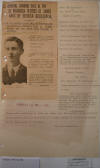
|
25. April 17,
1929. “EL GENERAL SANDINO
SALE AL FIN DE NICARAGUA DESPUES
DE VARIOS AÑOS DE HEROICA
RESISTENCIA - CON AUTORIZACION
DEL GOBIERNO DE HONDURAS PASARA
POR EL TERRITORIO DE ESE PAIS
CON RUMBO A MEXICO /
General Sandino at Last to Leave
Nicaragua after Several Years of
Heroic Resistance,” translation
of article from
La Tribuna
of San José, Costa Rica.
"EL GENERAL SANDINO SALE AL FIN
DE NICARAGUA DESPUES DE VARIOS
ANOS DE HEROICA RESISTENCIA ¶
CON AUTORIZACION DEL GOBIERNO DE
HONDURAS PASARA POR EL
TERRITORIO DE ESE PAIS CON RUMBO
A MEXICO ¶ El señor Cónsul de
Nicaragua, don Elie J. Hazera,
se sirvió ayer enterarnos del
siguiente despacho telegráfico
recibido por él: ¶ Managua,
Abril 15.- ¶ Cónsul Hazera, ¶
San José. ¶ El Ministro de
Nicaragua en Tegucigalpa, en
telegrama de hoy, dice: ¶ “El
Gobierno de Honduras acaba de
avisarme oficialmente que
permitirá el paso de Sandino por
el territorio de Honduras, quien
irá custodiado para evitar
manifestaciones. Se dirige a
México. ¶ J. F. Moncada” ¶
Sirvase dar publicidad al tener
noticia y decir que el país está
en completa tranquilidad, a
excepción de pequeña partida de
bandoleros que ha quedado
diseminada en el departamento de
Jinotega. ¶ Relaciones ¶ From
“La Tribuna” of San José--Costa
Rica. ¶ April 17, 1929. ¶
General Sandino at Last to Leave
Nicaragua After Several Years of
Heroic Resistance. ¶ With
Permission From The Government
of Honduras He Will Pass Through
That Country Enroute to Mexico.
¶ The Nicaraguan Consul, Don
Elie J. Hazera, was kind enough
yesterday to show us the
following telegraphic
information he had received: ¶
Managua, April 15th. Consul
Hazera, ¶ San José. ¶ The
Minister of Nicaragua in
Tegucigalpa, says in a telegram
to-day: ¶ The Government of
Honduras has just notified me
officially that it will permit
Sandino to pass through the
territory of Honduras, but in
custody to prevent any
demonstrations. He is going to
Mexico. ¶ J.F. Moncada. ¶ Please
give publicity to this and state
that the country is in complete
tranquillity, [tranquility,]
with the exception of a small
number of bandits scattered in
the Department of Jinotega. ¶
Foreign Relations."
|
|

|
26.
September 14,
1930. Rafael de Nogales, “More Light on ‘Bad Man’ Sandino
and How he Fights,”
The
Sunday Star, Washington
D.C., image 1.
"More Light on “Bad Man”
SANDINO and How He Fights ¶ This
Is the Nicaraguan General’s Own
Story of His War Against the
United States as Told to Rafael
de Nogales, Soldier of Fortune
Who Commanded a Division of
Turkish Troops for the Germans
During the World War and Who Was
With Sandino in the Jungles and
During His Exile in the Mexican
Capital. ¶ By Rafael de Nogales.
¶ Brig. Gen. Logan
Feland, U. S. M. C., who
commanded the United States’
forces in Nicaragua. ¶ One of
the best photos ever taken of
Augustino Sandino. He is shown
here placing a wreath on the
grave of Hidalgo in Mexico City,
capital of a free country which
Hidalgo helped to release from
foreign tyranny. ¶ Rafael de
Nogales, author of this article,
in Nicaragua. He is shown here
with Vice President Sacasa
(right) in Puerto Cabezas. ¶
Reminiscent of France. This was
no comic-opera warfare, for the
whole front of the Marines’
headquarters at Ocotal, is shown
here peppered with machine gun
and rifle fire. ¶ Capt. Richard
Livingston, U. S. M. C. His body
was found among 60 American
dead, Sandino told Nogales. But
here is the Marine captain at
the Naval Hospital in
Washington, very much alive,
though wounded, and there were 5
dead, not 60. ¶ THE purpose of
this story is not to picture
Augustino Sandino as patriot or
hero, but merely to draw a
sketch of the man as I know him
and to give, as he gave it to
me, some account of his
campaigns in Nicaragua. The data
cited directly from him were
given me in Mexico City recently
by Sandino himself and by his
aide de camp, Capt. Jose de
Paredes. ¶ I believe it is very
likely that Sandino is going to
continue his fight in Nicaragua.
He is there now. ¶ Sandino’s
retirement to Merida, Yucatan,
after his withdrawal from
Nicaragua, has been set down by
many as an admission of defeat,
and by others as the result of a
bribe of $60,000. ¶ But Sandino
himself told me—and I have every
reason to believe him—that he
was really calling what he
believes is a bluff by President
Moncada of Nicaragua. ¶ Moncada
has announced that if the rebels
would stop fighting the American
Marines would be withdrawn and
the country would enjoy true
democratic government. Sandino
simply hid his stores and arms,
disbanded his army, and
left—temporarily. The Marines
are still there. ¶ Perhaps by
the time this article is
published the whole bloody
business may have broken out
again. ¶ Sandino is neither a
Napoleon nor a Hottentot, but to
me he is a born leader of men
and a clever tactician after the
school of Abd-el-Krim of Morocco
fame. Like Abd-el-Krim, Sandino
succeeded in adapting modern
military tactics to the
topographic and climatic
conditions of the region in
which he was conducting his
military operations. ¶ Sandino
does not pretend to be a
Napoleon. He is just a plain,
self-made man, and he is proud
of it. He left his native
country, Nicaragua, at the age
of 16, in order to earn a living
abroad as a mechanic—first in
Costa Rica and later also in
Honduras, Guatemala, Mexico and
the United States. In the States
he learned to speak English
fairly well, while in Mexico he
got acquainted with the
doctrines of anti-imperialism. ¶
WHAT does Sandino want?
Ultimately, of course, the whole
Nicaraguan business revolves
itself into the matter of a new
canal to parallel the canal
across Panama, to take up
surplus traffic and serve its
own military needs. ¶ And
Sandino, contrary to general
opinion, is not at all opposed
to construction of the canal.
Being remarkably well versed in
such matters as economic
pressure and military necessity,
he knows at least that it is
inevitable, and all his
fanatical patriotism will not
blind him to that fact. ¶ What
he objects to is simply the way
in which the matter so far has
been planned and carried out.
The United States, through the
Bryan-Chamorro treaty, has
acquired the right to build and
operate the canal without
taxation for $3,000,000, and,
according to Sandino, only half
of that sum was actually paid to
the Diaz administration in
Nicaragua. Of that half, paid to
politicians who are now
discredited, little, if any,
seems to have gone into the
country’s treasury, he says. ¶
Sandino, who did his share of
fighting to get rid of Diaz,
simply claims that the latter
was bribed into betraying his
people and that Nicaragua’s
present President, Moncada, is
being bribed with equal success
to abide by a bad bargain. ¶
Sandino has several times told
me that what he wants for the
canal is a joint stock company,
half of the stock to be bought
by Latin American nations and by
Nicaragua in particular, and the
other half owned by the United
States and other nations. The
three million dollars already
paid by the United States are to
be applied in full to the
purchase price of shares. ¶ That
would give Nicaragua a steady
income with which to build
railroads, auto roads, sewers,
power plants, etc., without
having to appeal to foreign
capital and without being
subjected to the common
humiliation of hearing that
American Marines only go into
the Latin countries to “clean
them up.” ¶ MUCH has been
written and said about the
“backwardness” of Central
American republics and about the
“beneficial results” of American
occupations. Sandino, however,
has an answer to that. He claims
that this backwardness has been
fostered by American interests,
that revolutions and troubles
have for years been deliberately
stirred up in order to win
unlawful concessions from
temporary puppet governments. ¶
Roosevelt’s alleged fostering of
the Panaman revolution in order
to gain the rights to the canal
is given as an example. The
rebel leader claims that if the
unhappy nations of Haiti, Santo
Domingo and the rest of Central
America had been left alone,
instead of being made to wallow
in a state or [of?] artificially
fostered anarchy, they would
have been able to work out their
own salvations and follow in the
footsteps of Chile, Argentina
and Brazil. ¶ The justice of his
claims cannot be gauged at the
present time. I have seen more
of Central American revolutions
that the majority of people, and
I know that the “inside stories”
of most of these uprisings will
probably never be generally
known. Sandino talks earnestly
and well. His arguments, backed
up by action, coming from a man
of fixed purpose, have won him
many fanatical adherents and
constitute the greatest menace
today to American isthmian
supremacy. ¶ Knowing the man as
I do, I am convinced that he
will fight for his ideals until
he is killed. And after that,
knowing his tremendous
popularity and the indelible
stamp his personality leaves
wherever he goes, I am certain
that somebody else will take up
the fight. Not in warfare alone
has he trained his lieutenants.
¶ His popularity is not confined
to Nicaragua alone. It has
spread over all of Central
America, to Honduras, Guatemala,
Mexico. ¶ While he lived in
Merida he was one of the most
beloved men there, in spite of
the fact that he never showed
himself at public festivals or
other community gatherings. He
and his men lived in a house
that was given to them. They
slept in hammocks and lived
frugally without any show or
display whatever. ¶ There was no
surplus talk, no swashbuckling,
no Napoleonic strutting. From
several of the wealthy men of
the town he could have had
anything he wanted. He refused
all local aid from his
supporters in Nicaragua, and he
took only the barest
necessities. ¶ STORIES are heard
all over Central America of how
he went hungry again and again
to give food to poor people who
needed it more than he. Perhaps
they are untrue in fact, but
still they are true of the
character of the man as I know
him. ¶ His soldiers, many of
them mere boys of 16 or 17,
worship him with a fanatical
zeal, thoroughly convinced that
he is always just, even if
terribly severe. He himself, in
his awkward, clumsy way, is
extremely fond of these
“children” of his. ¶ Again and
again he makes one of those
dramatic gestures that stamp him
as a leader of men. They have
been ascribed to a clever and
subtle showmanship, and in
effect he is undoubtedly one of
the greatest showmen alive
today. Personally, however, I am
convinced that his actions are
prompted by a terrible
earnestness, and I doubt if he
himself is aware of playing to a
gellery. No matter. Whatever the
motive, the effect is the same,
and the effect is the only thing
that counts to the American
Marines and the Nicaraguan
canal. ¶ While he was operating
near El Chipote, for instance,
he took possession of the
American gold [unreadable] of
San Albino, where he had once
worked [unreadable] a common
laborer and where he had begun
to sow the seeds of revolution
among his countrymen. ¶ He
remembered that in his day, in
accordance with a custom
widespread throughout Latin
America, he had been paid only
in “scrips,” tokens that were
exchangeable in the company’s
commissary. The first thing he
did then was to call the
seventy-five laborers together
and ask them how much the mine
owed them in back wages. Every
penny of the claimed amount was
paid out of the gold on hand,
and every one of those men was
thereafter a loyal potential
fighter for Sandino. ¶ But the
mine workers were more valuable
where they were. For months
Sandino worked the mine for the
benefit of his cause and his
men. George Williams, the
English engineer, coined the
metal into $10 gold pieces
called “Indios,” which were used
as payment of wages and for food
bought from neighboring
ranchers. They won the leader
many volunteers. In Honduras the
“Indios” were sold for $20 each,
because they were made of pure,
unalloyed gold. ¶ When Sandino
evacuated the mine he refused to
destroy its machinery, partly
because he and his army might
need it again and partly because
his nation might some day need
it. ¶ THROUGH such methods he
pays his way and wins volunteers
and cash subscriptions. He
allows no rowdiness or
promiscuous looting. Some of his
foodstuffs, moreover, are grown
for him by his own men. The
wounded who are still able to do
a bit of work are sent behind
the lines and turned into
farmers. ¶ The San Albino gold
mine was equipped with the best
machinery of its kind found in
Nicaragua. His sparing that, in
spite of the fact that it was
American owned, was understood
and applauded by his followers.
His reasons were plain to them.
But not always is he so
considerate of foreign property.
¶ When he took possession of the
rich La Luz and Los Angeles
mine, on April 28,1928, he found
there 355 pounds of gold, which
he captured, and about four tons
of dynamite. The latter he used
to blow up the whole works,
machinery, galleries,
everything, with an explosion so
exuberant that people in
Honduras thought there had been
an earthquake. ¶ Again his
action may be interpreted as a
shrewd piece of showmanship, as
a gesture for mob support. ¶
George B. Marshall, however, the
superintendent of the mine, was
treated with utmost
consideration. He accompanied
Sandino for several months as
his prisoner, until he died of
fever on June 27, 1928. ¶ Where
Sandino obtains his arms is
still a mystery. At one time he
used old rifles that had seen
service in Mexico before, but
when he ran short of ammunition
for them he found several new
sources of supply. One of them
consisted of captured machine
guns, rifles, bullets and other
supplies of the U. S. Marine
Corps. ¶ But if he is popular
for his justness and for his
eagerness to pay his way and to
spare civil populations any
undue burdens, he is equally
famous for his great severity.
Among his own men discipline
must be maintained, and the
punishment for infractions is as
hard as it is swift. ¶
Punishment, as a rule, means
death by the firing squad. There
can be no imprisonment, because
he can hardly carry a calaboose
with him through the jungles. ¶
THE case of Antonio Galeana is
famous throughout Central
America. Galeana had been one of
Sandino’s officers, trusted,
loyal and zealous. But when he
violated a girl in a newly
occupied town the hand of the
commander was fearful and swift.
Galeana was court-martialed and
shot. ¶ And those methods,
“guerilla warfare on a large
scale,” are eminently suited to
his men and to the country in
which he operates. To us,
accustomed to European tactics
that involve enormous “overhead”
in the form of large camps,
supply depots, etc., they seem
like the methods of a loose
rabble, hence the term “bandit.”
But there is nothing loose about
them. The leader is too thorough
for that. Every move is
carefully planned and
commanded—and every command is
implicitly obeyed because of a
rigid and unrelenting
discipline. ¶ During the last
Sandino campaign I spent months
in Nicaragua as an independent
observer. Later I talked to him
again and again and checked his
statements by those of his aide
de camp, a young man, by the
way, who for a time went to
school in San Francisco. ¶ To a
trained military observer it
becomes apparent that Sandino’s
methods are those of a military
leader who, like Abd-el-Krim in
the deserts of Morocco, knows
how to adapt European methods to
local conditions. ¶ In his first
fight with the Marines at
Ocotal, May 16, 1927, Sandino
had only 60 men. Subsequently he
built up his force to a probable
maximum of 1,500. He could have
had many times that number, but
he purposely kept his forces low
to insure better mobility and
ease of supply and to keep the
drain on the civil population
down to a minimum. ¶ Early in
1927 two widely varied forces
opposed each other. The Marines
knew nothing of Sandino’s
methods of guerrilla warfare and
he knew nothing of theirs.
Attempts on the part of both
sides to adopt the opponent’s
tactics proved fatal. ¶ At Las
Flores the Nicaraguans made the
bad mistake of entrenching
themselves and waiting for the
enemy to attack—a mistake that
was made worse by the fact that
they neglected to cover their
flanks. The engagement ended in
a complete rout and the serious
loss to Sandino of about 60 men.
¶ The Las Flores engagement was
one of a number near El Chipote
that took place between November
and the middle of December in
1927. When Sandino noticed that
his ammunition was running short
and that the Americans were
closing in on him, he had
several hundred straw dummies
made and places in the firing
line to deceive the enemy while
he quietly retreated with all
his men to San Rafael del Norte,
over jungle trails they had
previously cut in preparation
for the move. It was here that
he met the American journalist
Carlton Beals, whose articles
created such a stir in certain
American circles. ¶ After that
retreat he stuck to his jungle
trails, set traps for the
Americans wherever possible, and
took the offensive. ¶ AGAINST
that kind of warfare, conducted
in the jungle country by men who
know their jungles and who
travel light and fast, European
tactics are practically useless.
¶ The Americans realized
perfectly the shortcomings of
their methods, but it was
impossible for them to use any
other. Napoleon discovered in
Spain that guerilla warfare is
possible only in a country where
the population is friendly.
Neither the Boers in South
Africa nor Abd-el-Krim in
Morocco could have had the
slightest measure of success if
they had not been in their own
native lands. ¶ It is possible
to travel light and move fast,
in small bands, when every farm,
every ranch, is a potential
source of shelter and military
aid, as they were to Sandino.
When the reverse is true, as it
was to the Marines, large
commissaries and large camps
have to be transported,
independent and cumbersome
systems of liaison and hospital
treatment have to be maintained.
¶ The U. S. Marines, rightfully
distrustful of the civil
population, made matters worse
through their strict methods.
Again and again they harassed
the peasants, hoping to get a
“bandit” or two. ¶ At the
present writing, with trouble
beginning faintly to stir again
in Nicaragua, reports are being
published that President Moncada
has ordered all the inhabitants
of the affected districts to
concentrate at certain points,
with the announcement that
everybody found outside of those
points after a given date would
be regarded with suspicion. The
order, to me, demonstrates the
insecurity that Moncada feels in
his position. ¶ The same move
was made by the Marines on
several occasions during the
last Sandino trouble. In general
it may be regarded as a military
necessity, used by Kitchener in
South Africa, by the French in
the Abd-el-Krim campaign and by
the Spanish in Cuba in the days
before ’98. ¶ BUT it has also a
highly undesirable effect from a
military point of view. ¶ A
hunted man is apt to feel the
uncertainty of his position and
even become an active enemy. In
Nicaragua it alienated friends,
made enemies out of neutrals and
increased enormously Sandino’s
popularity through the simple
example of contrast with his
methods. ¶ I talk here not as a
crusader or a propagandist
against the United States. Few
men know better than I what
brutalities are incident to any
war—and those of the Americans
were more than equaled, in the
time of battle, by the reprisals
of the Sandinistas. ¶ When I
arrived in Matagalpa, Nicaragua,
in 1927, after a hazardous three
months’ trip across the swampy
jungles of the Mosquito Coast
and Central Nicaragua, I warned
the Marines to try to reach an
agreement with Sandino rather
than embark on a war that had no
end in sight and that would make
the United States more hated
than ever in all of Latin
America. They treated me with
the utmost courtesy and
friendliness, but even if they
had wanted to heed my advice
they had their orders and no
choice in the matter. ¶
Sandino’s methods of waging
warfare are interesting to
study. In his country he can
skirmish indefinitely against
almost any number of men. ¶ But
his methods, while eminently
suited to his purpose, have
their darker side. They allow
for no quarter to prisoners or
wounded. Often he is hard enough
put to feed his own men, and a
prison camp in his rear, or a
hospital for Americans when his
own wounded often die for lack
of proper medical care, would be
a physical impossibility. ¶
Sandino has also to reckon with
the absolutely essential good
will of the civil population.
Every soldier knows that the
non-combatants, the people
behind the lines, are always far
more fierce and intolerant in
their hatred of the enemy than
the fighters themselves. The
civil population is perfectly
willing to support Sandino and
his men—is willing to support
many times their
number—especially when gold
“Indios” pay the way. ¶ SANDINO
is not afflicted with
blood-lust. But he cannot
jeopardize his standing with
those on whose help he must
depend, and, even if he could,
he could not spare the men to
guard prisoners and enemy
wounded against fanatical
non-combatants. ¶ The rebel’s
hemmed-in position, his
difficulties in getting
ammunition, etc., produced that
terrible hand-to-hand fighting
with machetes that Central
America is famous for. Often, no
doubt, the Marines found their
rifles and their machine guns
useless in jungle skirmishes,
again and again the machetes did
their terrible work, flashing
red in the semi-darkness of the
tropical forest. ¶ Capt.
Paredes, Sandino’s aide de camp,
has told me of that cry of the
wounded, “Shoot me, but
machetes, no!” ¶ Shoot?
Ammunition is scarce and must be
preserved. Machetes, knives,
daggers must take their place
whenever possible. Often, when
there was dynamite on hand after
a raid on some mine, the men
used homemade grenades, leather
sacks filled with explosives,
nails, slugs, bolts, empty
shells, anything that would
inflict damage and stampede the
mules of the enemy. ¶ In a
jungle campaign of this sort,
where the Sandino forces
assemble, attack in a wilderness
and melt away after the battle,
it is particularly difficult to
secure accurate facts about the
fighting. ¶ Naturally enough,
Sandino’s accounts of his
battles are widely at variance
with accounts of the same
battles as compiled by the
United States Marine Corps and
the American Government. ¶
Sandino has at times, for
instance, given out optimistic
estimates of the United States
forces which he has defied, as
being anywhere from 25,000 to as
many as 40,000. ¶ BUT as the
entire United States Marine
Corps has had a strength of only
about 20,000 during the years
since the war, it is evident
that Sandino’s enthusiasm may
have carried him away in some of
his statements. ¶ To contrast
the accounts of some of the
principal battles in Nicaragua
as given by Sandino and the
official reports of the same
battles as compiled by Marine
officers, however, is
interesting. ¶ For instance,
Sandino described to me as
follows the fight at Ocotal: ¶
He attacked Ocotal at the head
of 60 men on May 16, 1927.
Several hundred peasants of the
neighborhood sacked the
Diaz-Moncada partisans’ shops
while Sandino and his men kept
blazing away with their eight
machine guns at the garrison of
Ocotal, composed of about 200 or
300 Marines and a handful of
Nicaraguan gendarmes, who had
been pressed into service. ¶
Sandino said: “The enemy finally
intrenched [entrenched]
themselves in a city block where
we kept them surrounded and
peppered them liberally with our
machine guns from the
neighboring heights. We could
have dynamited the provisory
barracks if we had wanted to.
But we desisted because we did
not want to hurt the town people
who were not responsible. ¶
“During the 15 hours which the
fight lasted the Americans did
not try a single sortie. They
continued firing until dawn,
wasting lots of good ammunition.
After sunrise their fire
relented considerably, probably
because they were running short
of ammunition. That must have
been also the reason why they
did not try a sortie that
morning. ¶ “At 10 a.m. two
American airplanes arrived. They
bombed and machine-gunned
mercilessly the surrounding
houses and city blocks, causing
many casualties among the
defenseless civil population.” ¶
Sandino’s losses, according to
Capt. de Paredes, amounted to
seven men—three dead (among
these Col. Rufo Marin) and four
wounded. Two of Sandino’s men
who got drunk and fell into the
hands of the enemy were
exchanged afterward for two
American Marines whom the
Sandinistas captured near
Achoapa [Achuapa?]. ¶ CONTRAST
the above with Marine accounts:
¶ The Marines report that the
garrison at Ocotal consisted of
40 Marines and 48 Guardia, and
that no American Marines were
ever exchanged for bandits.
Sandino’s force was given by the
Marines as 300. ¶ In the
campaign against El Chipote
again there is great disparity
between Sandino’s account and
that of the Marines. Capt. De
Paredes describes the engagement
as follows: ¶ “An American
column, proceeding from
Telpaneca reached the outskirts
of Quilali. Sandino ordered his
lieutenant, Francisco Estrada,
[unreadable] ambush his forces
at Las Trincheras. On December
[unreadable] the Americans fell
into the trap. They were swept
by rifle and machine gun fire at
15 yards. Of the 300 Marines, 60
perished—the Sandinistas having
killed also the wounded who had
fallen into their hands. ¶ “Ten
loaded packmules, three of them
carrying ammunition, were
captured by the Nicaraguans. The
American column retreated in
confusion, taking along 18 of
their wounded. Half a mile away
the Marines intrenched
[entrenched] themselves, waiting
for reinforcements, probably.
Among the dead was found the
body of Capt. Livingston, the
leader of the column.” So much
for Paredes’ version of the
affair. ¶ BUT the Marines report
that Capt. Livingston is alive
and doing very nicely, thank
you, though he was wounded in
the fight. Five, not 60, Marines
were killed, the records at
Washington show. ¶ But one of
the broadest variations is found
in Sandino’s story of the battle
on the Cocos River, the last
major fight the Marines have had
in Nicaragua. Here is Sandino’s
version: ¶ “A column of 500
Marines was coming up the river
in five large barges. ¶ “After
several airplanes had passed
over the Sandinistas without
noticing them, the five barges
fell into an ambuscade. This
happened on August 7, 1928. Of
the second barge, which was
allotted to Capt. de Paredes,
only five or six Marines escaped
alive by clinging to the
opposite side of the barge. ¶
“The rest of the Marines and
native rowers were swept clean
off the barge by Paredes’
machine guns. Some of the
Marines had jumped overboard and
tried to drag the barge ashore,
firing at the same time at
Paredes and his men. But it was
of all no avail. They were mowed
down to a man. ¶ “Paredes saw
the first barge drift by,
rudderless. It had been also
swept clear of its hundred-odd
Marines. The third barge had
suffered a similar fate. The
fourth and fifth barges had
suffered only a few losses
because they had managed to land
most of their men before they
had been properly submitted to
the machine gun fire of the
Sandinistas. ¶ “The Marines of
those two barges, after jumping
ashore, intrenched [entrenched]
themselves hurriedly in a nearby
ranch house which had been
occupied only a few minutes
before by Sandino himself. The
Sandinistas, in the general
melee, tried, naturally, to
concentrate upstream while the
Marines—that is, those who
remained alive—assembled
downstream. The Sandinistas lost
four dead and three wounded; the
latter died shortly afterward
for lack of proper medical
attention. The Marines lost 130
men.” ¶ ONE Marine officer said
of this account that “it would
be less laughable if it was more
accurate.” Marine records
indicate that Capt. Merritt A.
Edson was in command of this
engagement of 47 enlisted men
and one officer. It was a
definite and complete defeat for
the outlaws, the Marines
maintain, and Capt. Edson’s
official report of his entire
loss in the skirmish was one
dead and three wounded. ¶ In
fact, the official U. S. Marine
Corps figures for casualties
during the entire Nicaraguan
occupation gave 25 dead, only 21
of these as the result of
conflict with forces led by
Sandino or his subordinates. ¶
Other sharp contrasts like the
above are to be found by
comparing reports of the two
sides. ¶ And while there is
expedience in Sandino’s type of
warfare, there is no hope of
military victory. If he starts
again, he and his men, with
enormous reserves of man power
to draw upon, can keep on
fighting and harassing any sized
force indefinitely. ¶
(Copyright, [unreadable])"
|
|
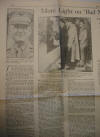
|
27.
September 14,
1930. Rafael de Nogales, “More Light on ‘Bad Man’ Sandino
and How he Fights,”
The
Sunday Star, Washington
D.C., image 2.
See transcription above (no.
26).
|
|
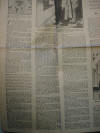
|
28.
September 14,
1930. Rafael de Nogales, “More Light on ‘Bad Man’ Sandino
and How he Fights,”
The
Sunday Star, Washington
D.C., image 3.
See transcription above (no.
26).
|
|
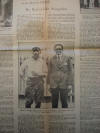
|
29.
September 14,
1930. Rafael de Nogales, “More Light on ‘Bad Man’ Sandino
and How he Fights,”
The
Sunday Star, Washington
D.C., image 4.
See transcription above (no.
26).
|
|

|
30.
September 14,
1930. Rafael de Nogales, “More Light on ‘Bad Man’ Sandino
and How he Fights,”
The
Sunday Star, Washington
D.C., image 5.
See transcription above (no.
26).
|
|
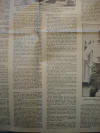
|
31.
September 14,
1930. Rafael de Nogales, “More Light on ‘Bad Man’ Sandino
and How he Fights,”
The
Sunday Star, Washington
D.C., image 6.
See transcription above (no.
26).
|
|
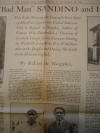
|
32.
September 14,
1930. Rafael de Nogales,
“More Light on ‘Bad Man’ Sandino
and How he Fights,”
The
Sunday Star, Washington
D.C., image 7.
See transcription above (no.
26).
|
|

|
33.
September 14,
1930. Rafael de Nogales, “More Light on ‘Bad Man’ Sandino
and How he Fights,”
The
Sunday Star, Washington
D.C., image 8.
See transcription above (no.
26).
|
|
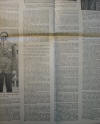
|
34.
September 14,
1930. Rafael de Nogales, “More Light on ‘Bad Man’ Sandino
and How he Fights,”
The
Sunday Star, Washington
D.C., image 9.
See transcription above (no.
26).
|
|
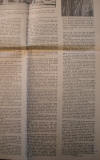
|
35.
September 14,
1930. Rafael de Nogales, “More Light on ‘Bad Man’ Sandino
and How he Fights,”
The
Sunday Star, Washington
D.C., image 10.
See transcription above (no.
26).
|
|

|
36.
September 14,
1930. Rafael de Nogales, “More Light on ‘Bad Man’ Sandino
and How he Fights,”
The
Sunday Star, Washington
D.C., image 11.
See transcription above (no.
26).
|
|
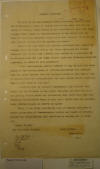
|
37. May 24, 1929.
G-2 Report on Sandino Situation,
Major Fred T. Cruse, Military
Attaché, Tegucigalpa.
"SANDINO SITUATION. ¶ In spite
of all the numerous rumors
concerning Sandino being out of
Nicaragua I think it certain
that he has never left the
vicinity of MURRA, in Nueva
Segovia. He has certainly not
been near Tegucigalpa either
openly or secretly, because in
the latter case the Chief of
Detectives, Francisco Moran
would have known of it and he
has just informed me that all
the reports are rumors. ¶
Tenorio has just cabled the
positive statement that Sandino
is between MURRA and SANTA CRUZ,
on the Poteca River, and the
further statement that he has
seen a letter from Sandino to a
politician in Honduras, dated
May 4, in which Sandino makes
the following statement
apparently in answer to some
question:-- ¶ “ The
distinguished patriot referred
to has returned his allegiance
to the burning sphere of
politics, forgetting that
politics will not remove Marines
from our outraged country. I
stay here. I will be here,
unafraid and untouched, when the
last Marine leaves Nicaragua.
Then we will consider politics.”
¶ I believe that is Sandino’s
intention. I also believe that
toward the end of March he was
rather desperate and made his
plans for getting out, but there
are indications that about this
time discontented Conservatives
began to give him a little help
and particularly information,
and he cheered up again. ¶ There
is one thing certain--as long as
Moncada continues to permit
persecution of Conservatives
Sandino can remain at liberty,
because the Conservatives will
retaliate by helping him in
every way. ¶ Report No.429. ¶
San Jose--May 24, 1929. ¶ Fred
T. Cruse, ¶ Major, G.S. ¶ M.A."
|
|
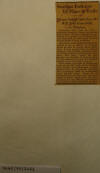
|
38. June 23, 1929.
“Sandino Entrains to Place of
Exile,”
Washington Post.
"Sandino
Entrains to Place of Exile ¶
Former Rebel Chief Says He Will
Live Peacefully in Yucatan.
¶ Guatemala City, June 23
(U.P.).—Augustino Sandino,
former Nicaraguan rebel leader,
and five companions, entrained
in a special car at Moran
Station, near here, at noon
today en route to their place of
exile in Mexico. ¶ The former
rebel chieftain said he intended
to go to Meridi, in Yucatan,
where he said he would reside
peacefully. He was accompanied
by Augusto Marques, Jose
Paredes, Gregorio Urbano, Ruben
Gomez and Tranquilino Joaquin.
The party, which has been
granted the privilege of
entering Mexico, was scheduled
to reach the Mexican frontier
town of Ayutia at 8 p. m. ¶ They
passed last night at Cuilapa
because of the bad roads which
hindered their journey from
Nicaragua to Guatemala City, via
Honduran Salvador. Two
automobile loads of Guatemalan
police escorted them. There was
no demonstration and the trip
was made almost in secret. None
of the men have passports but
the Mexican government has
extended border courtesies to
them."
|
|
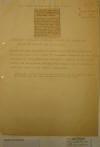
|
39. June 25, 1919.
“Government of Nicaragua
Officially Informed that Sandino
has crossed the Frontier enroute
to Mexico,” translation of
article from
Diario de Costa
Rica.
"From “DIARIO DE COSTA
RICA”---June 25, 1929. ¶
Oficialmente se informa al
Gobierno de Nicaragua que
Sandino cruzó la frontera de
Guatemala rumbo a México ¶
Managua, 25. – El Gobierno de
Nicaragua recibió un radiograma
informando que Sandino había
cruzado ya la frontera de
Guatemala, rumbo a México,
acompañado por cuatro personas.
Los periódicos de Managua
expresan su júbilo por la
aparente certeza de que Sandino
no será más un factor de
disturbios en los Departamentos
del Norte. ¶ GOVERNMENT OF
NICARAGUA OFFICIALLY INFORMED
THAT SANDINO HAS CROSSED THE
FRONTIER ENROUTE TO MEXICO. ¶
Managua--25…The Government of
Nicaragua has received a
radiogram staing [stating] that
Sandino had crossed the
Guatemalan border, enroute to
Mexico, accompanied by four
persons. The newspapers of
Managua express their delight
over the apparent certainty that
Sandino will no longer be a
troublesome factor in the
Northern Departments. ¶
NOTE..This is all that has been
published in any paper in Costa
Rica. There were not even
sub-headlines to this one."
|
|
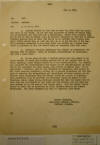
|
40. July 5, 1929.
G-2 Report on Sandino, Gordon
Johnston, Military Attaché,
Mexico City.
"1. Sandino arrived in Vera Cruz
on June 28, 1929, with his
staff, all armed to the teeth.
He had the full intention of
coming to Mexico City, and
arrangements had been made for a
celebration. Having been
informed that he was not to come
to Mexico City, he demanded
airplanes to take him to Merida,
Yucatan, stating that he dared
not travel on an American boat
because they would either poison
him, or sink the ship so as to
get him out of the way. The
Government consented to his
delay until the arrival of a
French boat, which is expected
to sail for Merida today or
tomorrow, from Vera Cruz. ¶ 2.
Sandino’s physical appearance
has created an unfavorable
impression here in Mexico. Small
in stature, insignificant in
appearance, and with a weak
voice. ¶ 3. In the press of July
2 Sandino states that his object
is to place himself in touch
with foreign nations who do not
realize that he is still
fighting, since Turcios ceased
to be his representative. Dr.
Machado was appointed his
representative but failed to act
satisfactorily; so that now he
has appointed Dr. Jose Zepeda,
who resides in Mexico City. He
is publishing a document, sent
to the President of Argentina,
with copies to all Latin
American countries, calling for
a general conference for the
purpose of securing the
independence and sovereignty of
these nations and to further
their friendship with the United
States on a basis of equality.
This conference also to consider
the important points in regard
to the Nicaragua Canal; among
these, Nicaragua should not sell
the rights but retain them for
the freedom of the Canal for all
nations, and not make the same
mistakes as in the case of the
Panama Canal. Also the United
States should be bound not to
intervene in Latin American
affairs nor foment revolution.
The about document was sent to
Argentina last March."
|
|
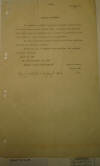
|
41.
November 11, 1929.
G-2 Report on Sandino Situation,
Major Fred T. Cruse, Military
Attaché, Tegucigalpa.
"The
enclosed handbills by Sandino
appeared at Bluefields and
Puerto Cabezas about October
21st. As Sandino was admitted
into Mexico upon his agreement
not to indulge in political
activities, this is a clear
violation of that agreement. ¶
In these circular he again
attacks Adolfo Diaz, Emiliano
Chamorro and Jose Maria Moncada.
¶ Toward the end of October
these circulars also appeared in
Corinto and Leon."
|
|
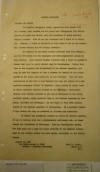
|
42. August 9,
1929. G-2 Report on
Sandino Situation, Major Fred T.
Cruse, Military Attaché,
Tegucigalpa.
"SANDINO SITUATION ¶ SANDINO
AND MEXICO ¶ The morning
newspapers state, apparently
with Mexico City as a source,
that Sandino and his group have
disappeared from Merida and are
en route for Belize, with the
intention of again entering
Central America. This is not yet
confirmed and I think it is
doubtful. However, I think it
advisable at this time to sum up
the connection between Mexico
and the Sandino movement. ¶ The
impetus of the whole Sandino
movement came from Mexico…not
the Government but the communist
and anti-imperialist groups in
that country. When Gustavo
Machado returned from a visit to
Sandino’s forces last year he
spent several days in
Tegucigalpa. During this time he
was received and entertained at
the Mexican Legation, and when
he left for Amapala to take a
steamer for Mexico he was
accompanied by Mr. Saenz Rico
Secretary of the Legation. This
was most astonishing as for over
a year Machado had been the
editor of a communistic
newspaper called “El Machete”,
every column of every issue of
which contained vicious attacks
on the Mexican Government.
Finally when Sandino decided to
get out of Nicaragua he was
given, entirely openly, every
possible help by the Mexican
Legation in Honduras, Salvador
and Guatemala. On the night of
June 20th Sandino stayed at the
Mexican Legation in Tegucigalpa.
In a previous report I have
stated the help he received in
Salvador and Guatemala. ¶ If
Mexico has permitted Sandino to
return to Central America, it
can be nothing else but a
deliberately unfriendly act, at
least toward the Government of
Nicaragua. From my observations
during the last year and a half
the whole attitude of the
Mexican Government in the
Sandino affair has been openly
unfriendly to the United States.
¶ Report No. 483 ¶ San
José--August 9, 1929 ¶ Sources –
Personal knowledge ¶ Fred T.
Cruse, ¶ Major G.S. ¶ M.A."
|
|
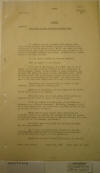
|
43.
January 31, 1930.
G-2 Report on Activities of C.
A. Sandino in Mexico City,
Gordon Johnston, Military
Attaché, Mexico City, p. 1.
"(COPY) ¶ 1 Encl. ¶ 2657-P-241 ¶
179 ¶ G-2 Report ¶ MEXICO ¶
SUBJECT: ¶ Activities of C.A.
Sandino in Mexico City. ¶ 1.
Sandino arrived in Mexico City
January 28th, 1930, coming by
plane from Merida, Yucatan, to
Tejeria, V.C., and thence by
rail to Mexico City. He did not
enter the city of Vera Cruz. All
papers of January 29th carry
reports of his visit, and
several reported interviews. A
resume of his statements to the
press follows: ¶ “I have come to
Mexico on personal matters.” ¶
“For us, Mexico is our school.”
¶ “I am now of the opinion, and
always will be to my death, that
I shall continue fighting for
the redemption of the Nicaraguan
people. I was obliged to leave
Nicaragua, but my army will
follow the plans already
determined upon. There are four
chiefs left in Nicaragua charged
with the custody of the arms and
ammunition of our army. You will
note that none of our arms have
fallen into the hands of our
enemies.” ¶ “Definitely and
categorically, in answer to your
question, I shall return to
Nicaragua.” ¶ Asked if he
understood how much influence
the United States had in Mexico,
he replied: ¶ “Not only here,
but in all parts of the world;
but everyone has the right to
clean out his own house.” ¶ “I
do not intend to visit people of
political importance in an
official character. Naturally,
however, I shall go to call upon
Calles, Sr. Portes Gil, and
Ortiz Rubio, to pay my respects
to them,- no more.” ¶ “Never for
a single moment have I abandoned
the patriotic cause of my
country, the triumph of which
the people of Nicaragua seek,
and are willing to continue
striving for, even at the cost
of the greatest sacrifices.” ¶
“We shall never stop until the
insolence of Uncle Sam has been
punished.” ¶ “Up to now, our
fighting for liberty has not met
with favorable response from the
Latin-American governments, but
it has among the people of those
countries.” ¶ Asked when he
would return to Nicaragua he
replied: ¶ From: M.A. Mexico. ¶
Report No. 2735. ¶ Date: Jan.
31, 1930."
|
|
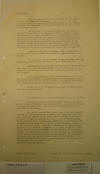
|
44.
January 31, 1930.
G-2 Report on Activities of C.
A. Sandino in Mexico City,
Gordon Johnston, Military
Attaché, Mexico City, p. 2.
"G-2
Report ¶ “The circumstances in
the case will fix the exact date
of my return to Nicaragua. . . .
Our army has struggled against
the greatest power in the world,
without aid, regardless of the
sacrifices and the sufferings
which they have met.” ¶ “At the
time of the negotiations with
the United States I first
thought of personally killing
Chamorro, Diaz, and Moncada, but
later thought that this would
bring about the useless
sacrifice of our people and
might have been construed as a
personal action of my own;
therefore I determined to take
upon my shoulders the entire
responsibility of the fight and
carry the banner of the
fatherland which Moncada has
cast to the ground, while he
occupied himself in rasping the
edge of his sword in the replete
money-bags of Uncle Sam.” ¶
Asked, in case of his triumph,
what he was going to do with
those who had sold themselves
for American gold, he replied: ¶
“If they come on their knees to
me, and weep, and ask
forgiveness, I would not be able
to order them killed.” ¶
“Furthermore, practically all
the people (of Nicaragua) even
under the present circumstances
where they appear to be
pacified, are really armed and
have hidden their arms in their
own houses.” ¶ “I am satisfied,
and it is my intuition, that in
the future America (Latin) and
Spain will clasp hands again,
forgetting all the effects of
the Conquest,- naturally when
Spain has another Government
substituted for the monarchy.” ¶
During his stay in Mexico City,
Sandino will be covered by a
special agent. ¶ 2. Movements
and actions of Sandino January
29, 1930. ¶ Sandino is staying
with Dr. Pedro Zepeda, who lives
at the corner of Ontario and
Alpea Streets, Chapultepec
Heights, a suburb of Mexico
City. Dr. Zepeda acts as
Sandino’s representative in
Mexico. ¶ The early part of the
morning was spent with Zepeda,
Estrada his so-called chief of
staff, his secretary Martinez,
etc. From 10 o’clock to 12 there
were a number of callers,-
personal friends, sympathizers,
etc.,- most of them unknown. It
is reported that no Government
officials or politicians of
importance were among them. At
12 o’clock Sandino, accompanied
by his personal party, deposited
a wreath at the Independence
Monument, and performed the
ceremony of Guard of Honor.
After this, they went to the
monument to the “Heroes of the
Military College” in Chapultepec
(graves of those killed by the
American troops during the
Mexican War). Agent states: “I
understand perfectly that he has
not visited any official
office.” He states that he had
enquired in various places and
was assured that Sandino had not
been there. . . . "
|
|
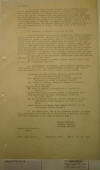
|
45.
January 31, 1930.
G-2 Report on Activities of C.
A. Sandino in Mexico City,
Gordon Johnston, Military
Attaché, Mexico City, p. 3.
"
. . . M.A. is reliably informed,
however, by an American business
man of unquestionable standing,
who had an appointment with
President Portes Gil at 1
o’clock on January 29th, that he
had to wait until nearly two, in
the anteroom before his
appointment was kept; meanwhile,
he saw Sandino and Dr. Zepeda
taken into the President’s
office, where they remained for
three quarters of an hour.
Sandino appeared to be in a very
happy humor on leaving. No
mention was made of this in the
press of the following day,
January 30th, nor was it
apparently known to press
correspondents or others, that
this visit to the President was
paid. ¶ 3. Movements of Sandino
on January 30, 1930. ¶ Until 10
o’clock in the morning Sandino
was receiving visitors at the
home of Dr. Zepeda. At 10 he
went to the office of Dr.
Zepeda, at Balderas 24, where a
considerable number of friends
and sympathizers called on him
until about noon. After lunch he
returned to the same office,
where he continued to receive
numerous visitors. Agent was
informed by Jose Constantino
Gonzalez, a member of Sandino’s
staff, that some forty or fifty
people had visited Sandino
during the day, counting among
them General Velasco (not on the
active list of the army), and
various officers of the Mexican
army, senators, deputies, and
some aviators. He was also
interviewed by correspondents of
various newspapers. ¶ At the
house of President-elect Ortiz
Rubio agent was informed that
Sandino had not been there. ¶
Sandino was invited to attend a
dinner tomorrow (Jan. 31st) at
the house of Guillermo Olivares.
¶ 4. A photograph is attached,
showing Sandino standing guard
after placing the wreath on the
Independence Monument. The names
of those accompanying him, from
left to right, are as follows: ¶
Licenciado Maraviac Morteau,
Haitian, representative of the
Anti-Imperialists of Haiti. ¶
Col. Agustin Marti,
representative of the people of
Salvador, and chief of Sandino’s
staff. ¶ Gen. Francisco Estrada,
Second in Command of Sandino’s
Nicaraguan Army. ¶ Agusto Cesar
Sandino. ¶ Dr. Pedro J. Zepeda,
representative of Sandino in
Mexico. ¶ Esteban Pavletish,
Peruvian; member of Sandino’s
staff. ¶ Jose Constantino
Gonzalez, Nicaragua, member of
Sandino’s staff. Dr. Enrique
Rivera Bertraud, Mexican;
President of the
Anti-Imperialistic League of the
city of Vera Cruz. ¶ Amado
Chaverri Matamoros, Costa Rican;
director of the publication
“Patria Grande”. ¶ 5. The
“Democrata”, one of the
afternoon dailies of Mexico
City, has begun the publication
of the history of Sandino, the
first instalment appearing in
the issue of January 30th. ¶
Gordon Johnston, ¶ Colonel,
Cavalry, ¶ Military Attache. ¶
Source: Confidential; ¶ Press. ¶
From: M.A. Mexico. ¶ Report No.
2735. ¶ Date: Jan. 31, 1930."
|
|
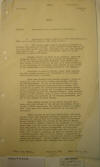
|
46.
February 6, 1930.
G-2 Report on Activities of C.
A. Sandino in Mexico City,
Gordon Johnston, Military
Attaché, Mexico City, p. 1.
"(COPY) ¶ S E C R E T ¶ G-2
Report ¶ 2657-P-241 ¶ 181 ¶
MEXICO ¶ SUBJECT: Activities of
C. A. Sandino in Mexico City. ¶
1. Reference is made to Report
No. 2736 dated February 3, 1930,
and to earlier reports, upon
above subject. ¶ 2. The special
agent reports Sandino’s
activities on February 4th,
1930, as follows: In Dr.
Zepeda’s office from 11 a.m. to
2 p.m. when he went to lunch,
returning to 3 p.m. and
remaining there until 8 p.m.
Agent was with Sandino from 4 to
8 p.m. ¶ Following is quoted
from Agent: ¶ “Sandino placed
his files at my disposal. Among
the documents which I read today
is a project of unification of
all the Spanish-American
countries, which project Sandino
states he will carry out as soon
as he takes possession of the
Government of Nicaragua, which
depends on the success of the
conferences he is holding
nightly in this Capital. ¶
“According to General Sandino,
every night sessions are held
between persons most in the
so-called ‘anti-imperialistic’
movement. ¶ “From some phrases
which Sandino dropped I could
observe that they are not on a
very good footing with the
Mexican Government. In one of
the letters which I read, sent
by Zepeda (Sandino’s
representative in Mexico City)
to Sandino, I noted the
difficulties which Sandino
encountered in donating to
Mexico the ‘trophies’ obtained
by him in the struggle against
the American marines. Said
trophies consist of two surgical
cases, a rifle and an American
flag, which objects, by
agreement of the Mexican
Government, are now in the
Mexican National Museum. ¶ “Upon
asking Sandino if the secret
sessions were being held with
members of the Mexican
Government, he appeared a little
suspicious, and confined himself
to saying that ‘they were with
persons interested in the cause
of Nicaragua’. ¶ “After showing
me air maps, small books, and
other objects taken from
American prisoners belonging to
the 5th Regiment, he told me
that in a certain place in
Nicaragua he was keeping hidden
the remains of the aviator
Thomas, of Captain E. A. Rector,
chief of the squadron, of a
doctor whose name I do not
recall at this moment, of
Captain William Williamson, of
Captain Livingston, of
Lieutenant Bruce, and of another
aviator whose name also I do not
recall, also of Roy A. Johnston,
an American engineer who on a
certain occasion went to him to
propose a conference in order to
settle a conflict, with the sole
object of assassinating him
(Sandino). Sandino himself told
me he would return the said
remains when Nicaragua was free
again. . . ."
|
|
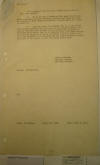
|
47. February 6, 1930.
G-2 Report on Activities of C.
A. Sandino in Mexico City,
Gordon Johnston, Military
Attaché, Mexico City, p. 2.
" . . . It is assumed that the
usual secret session will be
held this evening.” ¶ 3. As to
the day of February 5th, Agent
reports the usual procedure,-
Sandino receiving visitors and
going out with Dr. Zepeda for
some unknown destination to
which Agent was unable to trace
him. ¶ 4. Agent’s report for
February 6th is to the effect
that Sandino remained the entire
day in Dr. Zepeda’s office,
receiving visitors; that Sandino
did not attend the inaugural of
President Ortiz Rubio; that he
is becoming much less
communicative, and does not
appear to be in as optimistic a
mood as first; that it is not
believed he is receiving any aid
from the Mexican Government, and
it is thought he will soon leave
Mexico City. ¶ Gordon Johnston ¶
Colonel, Cavalry ¶ Military
Attache. ¶ Source: Confidential.
¶ J/p ¶ From: M.A.Mexico. ¶
Report No. 2743. ¶ Date: Feb. 6,
1930."
|
|
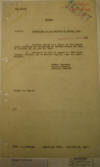
|
48.
February 18, 1930.
G-2 Report on Activities of C.
A. Sandino in Mexico City,
Gordon Johnston, Military
Attaché, Mexico City, p. 1.
"G-2 Report ¶ MEXICO ¶ SUBJECT:
Activities of C.A. Sandino in
Mexico City. ¶ 1. Attached
hereto is a report of the
special agent regarding the
activities of Sandino during the
days of February 13, 14, and 15,
1930. ¶ 2. Reference is made to
report No. 2759 dated February
13, 1930, and to earlier
reports, upon the above subject.
¶ Gordon Johnston, ¶ Colonel,
Cavalry. ¶ Military Attaché. ¶
Source: As stated. ¶ J/p ¶ From:
M.A.Mexico. ¶ Report No. 2765. ¶
Date: Feb. 18, 1930."
|
|
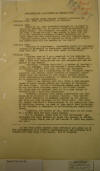
|
49.
February 18, 1930.
G-2 Report on Activities of C.
A. Sandino in Mexico City,
Gordon Johnston, Military
Attaché, Mexico City, p. 2.
"Activities of C.A.
Sandino in Mexico City.
¶ The special agent reports
Sandino’s movements on February
13th, 14th, and 15th, 1930, as
follows: ¶ February 13th: ¶
“Arose at 11, took breakfast,
returned to Dr. Zepeda’s office
on Balderas St. to receive
visitors, increasing in number
daily. His afternoon was spent
in the same way, and when I
called at 6:30 I was unable to
talk with him as he was
receiving intimate friends,
including two or three women who
were entertaining him with
Mexican songs. I learned,
however, that he expects to
leave Mexico City at any moment,
with all the members of his
staff.” ¶ February 14th: ¶
“Nothing of importance.
Increasing number of visitors.
Sandino is preparing to leave;
date uncertain; was unable to
talk with him. Most of his time
spent in diversion.” ¶ January
15th: ¶ “Sandino rose at 1 p.m.,
remained in the Balderas St.
house until 3 when he went out
to eat. At 8 o’clock p.m., when
I left said house, he had not
yet returned, but was expected
at any moment. ¶ “Pavletich
(Esteban Pavletich), a member of
Sandino’s staff, is missing;
left Gen. Sandino’s house,
Balderas 24, on February 13th at
2:30 p.m. and has not returned.
¶ “Pavletich was a collaborator
of the ‘Nacional Revolucionario’
and Colonel Martí (another of
Sandino’s staff) talked with the
manager of that paper, Senator
Manlio Fabio Altamirano, who
promised to order an
investigation as to Pavletich’s
whereabouts. ¶ “While I was
talking with Col. Martí a
well-dressed woman of about
thirty, called and inquired if
Pavletich had been found. She is
a Nicaraguan, speaks good
English as she has lived
fourteen years in the United
States. Her first name is
Soledad, said to be a good
friend of Sandino’s, but I find
her suspicious. ¶ “Sandino’s
friends have become distrustful
and have taken on an attitude of
absolute reserve. They believe
that their telephone is censored
by the police, and they are very
cautious in all their acts. They
will not report Pavletich’s
disappearance to the police, for
fear of involving Sandino, as
some of them admit that
Pavletich, if not actually a
communist in affiliation, has
communistic ideas. ¶ “Regarding
the arrest of Col. Martí, this
is not true, as I talked with
him last night myself. ¶ “As to
Sandino, Martí told me that he
(Sandino) was arranging the last
details to begin his journey to
Mérida, Yucatán, where twenty
men of the General’s staff are
awaiting him.” ¶ It has been
since learned that Pavletich got
mixed up in the infringement of
a traffic regulation, and was
arrested as a witness, but held
only a few hours. Now at
liberty. . . . "
[This document translated
via the kind courtesy of Walter
C. Sandino. // Este
documento traducido a través la
amable cortesía de Walter C.
Sandino:]
"Actividades de C. A. Sandino en
la Ciudad de Méjico ¶
El agente especial, reporta los
movimientos de Sandino del 13 de
febrero, 14 y 16, de 1930, a
como sigue: ¶
Febrero 13: ¶ "Se
levanto a las 11 am, tomo
desayuno, regreso a la oficina
del Dr. Zepeda en la calle
Balderas para recibir
visitantes, las cuales aumentan
en número diariamente. Su
tarde la paso de igual forma y
cuando yo llegue a las 6:30 pm,
yo no pude hablar con él, ya que
estaba recibiendo a amigos
íntimos, incluyendo dos o tres
mujeres quienes lo estaban
divirtiendo con canciones
mexicanas. Yo supe sin
embargo, que él espera partir de
la Ciudad de Méjico en cualquier
momento, con todos los miembros
de su personal" ¶
Febrero 14: ¶ "Nada
de importancia. Aumentando
el número de visitantes.
Sandino está preparándose para
marcharse; fecha incierta, no
pude hablar con él. La
mayor parte de su tiempo lo pasa
divirtiéndose." ¶
Febrero 15: ¶
"Sandino se levanto a las 1 pm,
permaneció en la casa de la
calle Balderas hasta las 3 pm
cuando salió a comer. A
las 8 pm cuando yo abandone la
mencionada casa, el aun no había
regresado, pero se le esperaba
en cualquier momento. ¶
"Pavletich (Esteban Pavletich),
un miembro del personal de
Sandino esta desaparecido;
abandono la casa del general
Sandino, Balderas 24, el 13 de
febrero a las 2:30 pm y aun no
ha regresado. ¶
"Pavletich era un colaborador
del "Nacional Revolucionario" y
el coronel Martí (otro del
personal de Sandino) hablo con
el gerente de ese periódico,
Senador Manlio Fabio Altamirano,
quien prometió ordenar una
investigación para saber sobre
el paradero de Pavletich.
¶ "Mientras conversaba el
Coronel Martí una mujer muy buen
vestida de unos treinta años,
llego y pregunto acerca de
Pavletich, su paradero y que si
él había sido encontrado. Ella
es nicaragüense, habla muy buen
ingles, ya que ella ha vivido 14
años en los Estados Unidos.
Su primer nombre es Soledad,
dijo ser una buena amiga de
Sandino pero yo la encuentro
sospechosa. ¶ "Los
amigos de Sandino se han vuelto
desconfiados y han tomado una
actitud de absoluta reserva.
Ellos creen que su teléfono esta
censurado (intervenido) por la
policía y están siendo muy
cautelosos en todos sus actos.
Ellos no reportaran la
desaparición de Pavletich a la
Policía, por temor de involucrar
a Sandino, ya que algunos de
ellos admiten que Pavletich,
sino es actualmente un comunista
de afiliación, tiene ideas
comunistas. ¶ "Con
respecto al arresto del Coronel
Martí, esto no es verdad, ya que
yo hable con él anoche. ¶
"Con respecto a Sandino, Martí
me dijo que él (Sandino) estaba
arreglando los últimos detalles
para comenzar su viaje hacia
Mérida, Yucatán, donde 20
hombres del personal del General
lo están esperando“. ¶
_____________________ ¶ Se
ha sabido últimamente que
Pavletich se involucro en la
violación de las Leyes del
Trafico, y fue arrestado como
testigo, pero retenido solo unas
pocas horas. Ahora está en
libertad."
[NOTE: The previous
special agent report for Feb.
8-12 can be found on
TOP 100, PAGE 95, PAGE
5, DOCS 9 & 10.
// NOTA: El informe
anterior del agente especial de
8 a 12 febrero se encuentra en
el
TOP 100, PAGE 95, PAGE
5, DOCS 9 & 10.]
|
United States National Archives, Record Group
165, Entry 77, Box 2653.
|

